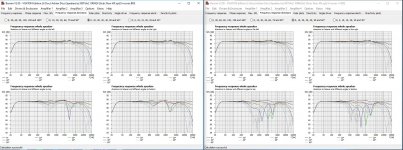Having lurked, asked stupid questions and been down a number of blind alleys (and been re-directed by those with much more knowledge than I will ever have, thanks), I think I have converged on a Project Idea.
So, I will try and explain it (only modeled so far) and I would be grateful of any comments that either confirm this has a good chance of working or where I need to sort stuff out.
1) Enclosure
Tallish, slim floorstander - external - 100h x 23w x 30d cm - 25mm ply with window bracing and 28mm butchers block baffle = 40l internal volume, will be lined, mid will be in separate enclosure approx 1 liter (probably fibreglass moulded around coke bottle, stuffed and sealed to baffle).
2) Architecture
Simple TMWW - active system with Minidsp crossover, anechoic correction (notches) and room EQ. I have two Rotel RMB1066 which can supply 150w in 8 ohm x 2 and 60w into 8 ohms x 2 each - one for each speaker . Therefore Woofers need to be 8 ohm.
3) Driver Choice (UK location so limits some choices)
Woofer - Dayton ES180TiA-8 - modeled in 20l with 30Hz tuning for port (5cm diam x 15-20cm long, both ends flared) x2 (in same enclosure of 40l).
Mid - Scanspeak 10F8424 - modeled in 1l close, stuffed box
Tweeter - SB26CDC
Not the cheapest drivers but all get good comments for their transparency and dynamics and woofers and mid share a similar construction.
4) Modelling (graphs provided)
Carried out in Boxsim v2.0 (Active filters, all driver in phase, all 4th order crossovers (2 x lowpass 2nd order)) and using Dayton's provide FRD/ZMA plus traced for the mid/tweeter - using manufacturers TS parameters. Initial parameters input then used the optimiser to refine.
All models are with zero offset/gain - this combination seems to work very well straight out of the box.
A) Low/traditional crossover - approx - 270Hz and 2800Hz
Woofer - Lowpass 2nd order x2 - 450Hz/0.57 + 266Hz/0.76 plus two parametric notches - 65Hz/3.75/1.25dB and 45Hz/3/-1.25dB
Mid - Highpass 2nd order x2 - 460Hz/0.89 + 306Hz/0.69 and Lowpass 2nd order x2 - 2050Hz/0.57 + 3150Hz/1.09 plus delay auto calc'd.
Tweeter - Highpass 2nd order x2 -1935Hz/0.49 + 2115Hz/0.45 plus delay auto calc'd.
This produced a nice flat frequency profile with just 2 parametric notch filters (to sort out bass end) and no gain leveling. However I think the low crossover is pushing the small 10f so modeled a higher crossover -
B) Higher Mid Crossover - approx - 550Hz and 3100Hz
Woofer - Lowpass 2nd order x2 - 610Hz/0.5 + 510Hz/0.7 plus two parametric notches - 65z/3.75/1.25dB and 45Hz/3/-1.25dB
Mid - Highpass 2nd order x2 - 570Hz/0.95 + 530Hz/0.7 and Lowpass 2nd order x2 - 2600Hz/0.75 + 3500Hz/0.75 plus delay auto calc'd.
Tweeter - Highpass 2nd order x2 -2780Hz/0.7 + 3550Hz/0.65 plus delay auto calc'd. Also added a parametric notch filter at 5100Hz/2/-2db.
This seems to model slightly better. at 88sB +/-1dB from 33Hz to 20kHz and F3 at about 29Hz
Options - I did look at the Anarchy 708 for woofers but these are out of stock and by the time you add shipping and tax for 4 they are close to the Daytons in price. For mids I modeled the Satori MR13P and MW13P, the 10F4424 and the Morel EM1308 but the 10F8424 modeled the best. For tweeter I looked at and modeled the 29RDC, Satori TW29R(N) and the 21RDC and 26ADC but again the 26CDC seemed to do the best job.
So, I have attached the frequency plots for the two models and the phase plots plus the box model if anyone feels the need to replicate and check it out.
But from my amateur/inexperienced standpoint this looks like a good combination for a transparent/dynamic, smallish floor stander that is pretty flat from 30Hz to 20kHz and need very little (if none) gain leveling and only minor notches to wrinkle out the dips/peaks (three actually).
So, all comments/suggestions welcome as I am here to learn so there is no need to be polite/gentle, I do not take offense easily.
So, I will try and explain it (only modeled so far) and I would be grateful of any comments that either confirm this has a good chance of working or where I need to sort stuff out.
1) Enclosure
Tallish, slim floorstander - external - 100h x 23w x 30d cm - 25mm ply with window bracing and 28mm butchers block baffle = 40l internal volume, will be lined, mid will be in separate enclosure approx 1 liter (probably fibreglass moulded around coke bottle, stuffed and sealed to baffle).
2) Architecture
Simple TMWW - active system with Minidsp crossover, anechoic correction (notches) and room EQ. I have two Rotel RMB1066 which can supply 150w in 8 ohm x 2 and 60w into 8 ohms x 2 each - one for each speaker . Therefore Woofers need to be 8 ohm.
3) Driver Choice (UK location so limits some choices)
Woofer - Dayton ES180TiA-8 - modeled in 20l with 30Hz tuning for port (5cm diam x 15-20cm long, both ends flared) x2 (in same enclosure of 40l).
Mid - Scanspeak 10F8424 - modeled in 1l close, stuffed box
Tweeter - SB26CDC
Not the cheapest drivers but all get good comments for their transparency and dynamics and woofers and mid share a similar construction.
4) Modelling (graphs provided)
Carried out in Boxsim v2.0 (Active filters, all driver in phase, all 4th order crossovers (2 x lowpass 2nd order)) and using Dayton's provide FRD/ZMA plus traced for the mid/tweeter - using manufacturers TS parameters. Initial parameters input then used the optimiser to refine.
All models are with zero offset/gain - this combination seems to work very well straight out of the box.
A) Low/traditional crossover - approx - 270Hz and 2800Hz
Woofer - Lowpass 2nd order x2 - 450Hz/0.57 + 266Hz/0.76 plus two parametric notches - 65Hz/3.75/1.25dB and 45Hz/3/-1.25dB
Mid - Highpass 2nd order x2 - 460Hz/0.89 + 306Hz/0.69 and Lowpass 2nd order x2 - 2050Hz/0.57 + 3150Hz/1.09 plus delay auto calc'd.
Tweeter - Highpass 2nd order x2 -1935Hz/0.49 + 2115Hz/0.45 plus delay auto calc'd.
This produced a nice flat frequency profile with just 2 parametric notch filters (to sort out bass end) and no gain leveling. However I think the low crossover is pushing the small 10f so modeled a higher crossover -
B) Higher Mid Crossover - approx - 550Hz and 3100Hz
Woofer - Lowpass 2nd order x2 - 610Hz/0.5 + 510Hz/0.7 plus two parametric notches - 65z/3.75/1.25dB and 45Hz/3/-1.25dB
Mid - Highpass 2nd order x2 - 570Hz/0.95 + 530Hz/0.7 and Lowpass 2nd order x2 - 2600Hz/0.75 + 3500Hz/0.75 plus delay auto calc'd.
Tweeter - Highpass 2nd order x2 -2780Hz/0.7 + 3550Hz/0.65 plus delay auto calc'd. Also added a parametric notch filter at 5100Hz/2/-2db.
This seems to model slightly better. at 88sB +/-1dB from 33Hz to 20kHz and F3 at about 29Hz
Options - I did look at the Anarchy 708 for woofers but these are out of stock and by the time you add shipping and tax for 4 they are close to the Daytons in price. For mids I modeled the Satori MR13P and MW13P, the 10F4424 and the Morel EM1308 but the 10F8424 modeled the best. For tweeter I looked at and modeled the 29RDC, Satori TW29R(N) and the 21RDC and 26ADC but again the 26CDC seemed to do the best job.
So, I have attached the frequency plots for the two models and the phase plots plus the box model if anyone feels the need to replicate and check it out.
But from my amateur/inexperienced standpoint this looks like a good combination for a transparent/dynamic, smallish floor stander that is pretty flat from 30Hz to 20kHz and need very little (if none) gain leveling and only minor notches to wrinkle out the dips/peaks (three actually).
So, all comments/suggestions welcome as I am here to learn so there is no need to be polite/gentle, I do not take offense easily.
Attachments
-
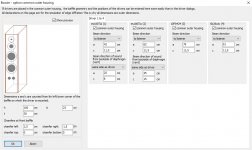 ES180TiAx2 10F8424 26CDC Box.JPG79.6 KB · Views: 526
ES180TiAx2 10F8424 26CDC Box.JPG79.6 KB · Views: 526 -
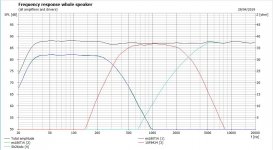 ES180TiAx2 10F8424 26CDC Freq low xover.JPG135.1 KB · Views: 527
ES180TiAx2 10F8424 26CDC Freq low xover.JPG135.1 KB · Views: 527 -
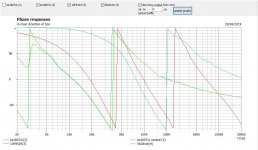 ES180TiAx2 10F8424 26CDC Phase low xover.JPG122.7 KB · Views: 516
ES180TiAx2 10F8424 26CDC Phase low xover.JPG122.7 KB · Views: 516 -
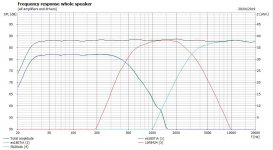 ES180TiAx2 10F8424 26CDC Freq Hi xover.JPG131.5 KB · Views: 516
ES180TiAx2 10F8424 26CDC Freq Hi xover.JPG131.5 KB · Views: 516 -
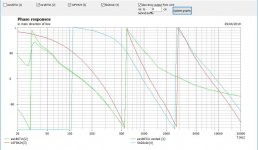 ES180TiAx2 10F8424 26CDC Phase Hi xover.JPG123.3 KB · Views: 517
ES180TiAx2 10F8424 26CDC Phase Hi xover.JPG123.3 KB · Views: 517
I'd definitelly go for B crossover. 2xES180 can take a lot of power. Smalish midrange as 10f is will run out of juice much before one (let alone two) es180's brake a sweat. I think that your choice of drivers is very good but i'd add another 10f and make it an mtm with 26cdc.
Last edited:
Could you please post a simulated impedance plot? I know, you want to go active but I'm interested in how the mid reacts in such a small volume, from my estimate I'd probably give it more volume, maybe 3l? Does that come close to a Qt of 0,5? How does the simulation look under angles?
The Anarchy 708 is more of a subwoofer than a woofer. With 250Hz xo that's not critical but I would not xo it higher if you want to play loud, the big excursion would introduce intermodulation distortion. That's not just with this driver, that applies to all with high excursion (if that is actually used).
The Dayton ES180TiA-8 is a good choice but quite expensive IMO.
The Anarchy 708 is more of a subwoofer than a woofer. With 250Hz xo that's not critical but I would not xo it higher if you want to play loud, the big excursion would introduce intermodulation distortion. That's not just with this driver, that applies to all with high excursion (if that is actually used).
The Dayton ES180TiA-8 is a good choice but quite expensive IMO.
Thanks guys for the comments, much appreciated.
You are correct the SPL limiting factor is the 10F8824 (at just over 100dB) if I get a chance I will try doing a MTMWW model tomorrow evening, the two 10F will be in parallel to give 4ohms which the Rotel should be ok with if using it at 60W and not bridged.
I will try and post impedance plots but as it is an active crossover I am not sure how good they will be.
On the mid enclosure side using MH-Audio sealed box calculator, Qt=0.5 gives a volume of 2.5l. For a 1l volume the Qt=0.65.
You are correct the SPL limiting factor is the 10F8824 (at just over 100dB) if I get a chance I will try doing a MTMWW model tomorrow evening, the two 10F will be in parallel to give 4ohms which the Rotel should be ok with if using it at 60W and not bridged.
I will try and post impedance plots but as it is an active crossover I am not sure how good they will be.
On the mid enclosure side using MH-Audio sealed box calculator, Qt=0.5 gives a volume of 2.5l. For a 1l volume the Qt=0.65.
Simulation shows flat on-axis response. How about baffle step compensation below 500Hz?
SS 10F is actually a 3" driver ( radiating area ¤ 68mm), so for sure it will be the first to get stressed. Find something with at least 100mm diameter of membrane, preferably around 120mm like Peerless NE123, SS 15M
SS 10F is actually a 3" driver ( radiating area ¤ 68mm), so for sure it will be the first to get stressed. Find something with at least 100mm diameter of membrane, preferably around 120mm like Peerless NE123, SS 15M
Simulation shows flat on-axis response. How about baffle step compensation below 500Hz?
SS 10F is actually a 3" driver ( radiating area ¤ 68mm), so for sure it will be the first to get stressed. Find something with at least 100mm diameter of membrane, preferably around 120mm like Peerless NE123, SS 15M
Thanks for the comments, much appreciated.
As the Boxsim model has an enclosure defined in it I would have thought that the Baffle size/shape would be taken into account. Boxsim outputs a frequency plot off exit (both line curves and colour plot), will try and post it tonight. Can also post the ES180TiA individual driver plot that shows raw data, with baffle adjustment and with active/passive crossover. Hope that will help.
I have looked at the NE123 and also the larger Satori 16's but they do not simulate as well as the 10F and I was worried about the comments about "beaming" i.e. less off axis fidelity for the larger mids.
I have measured and used 90-150mm diameter midranges, and rising directivity above 2-3kHz is easily masked by the tweeter's overlap having no directivity. Xo frequency and steepness both play a role. LR2 has rather mellow slopes and is more forgiving than the popular LR4.
This SB15MFC-30 is an exceptional midrange, which has rising on-axis response when beaming happens - above 3kHz. https://hificompass.com/sites/default/files/documents/5in_sb15mfc30-4.pdf
SS 10F has Sd 36cm2 but SB15 has 82cm2 (diameter 120mm), quite a difference!
I don't know if Boxsim can simulate power response. I haven't learned to use simulations, I just make a proto box and measure drivers in it. Then I have real data and with minidsp or other dsp-xo I can easily test different xo topologies.
If you are designing passive crossover, safest way is to measure drivers in the box also off-axis and use that data with Vituixcad.
This SB15MFC-30 is an exceptional midrange, which has rising on-axis response when beaming happens - above 3kHz. https://hificompass.com/sites/default/files/documents/5in_sb15mfc30-4.pdf
SS 10F has Sd 36cm2 but SB15 has 82cm2 (diameter 120mm), quite a difference!
I don't know if Boxsim can simulate power response. I haven't learned to use simulations, I just make a proto box and measure drivers in it. Then I have real data and with minidsp or other dsp-xo I can easily test different xo topologies.
If you are designing passive crossover, safest way is to measure drivers in the box also off-axis and use that data with Vituixcad.
Last edited:
I will try and post impedance plots but as it is an active crossover I am not sure how good they will be.
It will show how close its resonance frequency is to the crossover point. You can also calculate the actual power it has to take for the spl.
Ok, so ran a second model -
1st model (left) as above with TMWW Single Amp for T, M and Parallel WW. Everything as before - zero gain leveling (all at zero gain), crossovers/delay as before and parametric three notch filter - two woofer and one tweeter.
2nd model (right) now MTMWW - single amp for each woofer, amp for mids in parallel and amp for tweeter - zero gain on T and W's, -6db on mids, everything else unchanged. Slight mod to the box - increase to 110cm high (to account for the extra driver volume, Woffers still in 40l box) and increase the mid volume to 2.5l closed/sealed (Q=0.5) as suggested.
Also provide single ES180TiA driver frequency plot showing that it looks like the modelling takes the raw driver data (from graphs/OEM, assumes half room response), applies a baffle step based on baffle geometry and driver spec ,then applies the passive (none) and active crossovers/filters and finally adds in any port addition. In this case it looks like it is balancing the baffle step reduction with the crossover to provide the flat response. \So baffle step is taken into account as far as I can see and starts correctly at 500Hz.
So below/attached are -
1st Model TMWW - single ES180TiA Frequency plot (as requested)
1st Model TMWW Impedance plot for the three amps (as requested) - note I think the amp will only see the basic impedance of the raw driver as it is connected directly to it.
1st Model TMMW vs 2nd Model MTMWW - Frequency, Impedance, Max SPL, Directive Vertical/Horizontal and phase.
Hopefully this provides you with a bit more information to scrutinise. The addition of the second mid does help the max SPL and I think the model uses the Xmax to calculate this rather them max power handling but could be wrong. To be honest I do not need to play at party levels (although my main listening is Metal/Dject/Prog rock) so max SPL is not such a big Issues so with the twin mids giving 110ish Db that is plenty (normal listening around 80dB(a) so plenty of head room).
Again all comments welcome, I have so much to learn, and thanks already for your helpful suggestions they are very much appreciated.
1st model (left) as above with TMWW Single Amp for T, M and Parallel WW. Everything as before - zero gain leveling (all at zero gain), crossovers/delay as before and parametric three notch filter - two woofer and one tweeter.
2nd model (right) now MTMWW - single amp for each woofer, amp for mids in parallel and amp for tweeter - zero gain on T and W's, -6db on mids, everything else unchanged. Slight mod to the box - increase to 110cm high (to account for the extra driver volume, Woffers still in 40l box) and increase the mid volume to 2.5l closed/sealed (Q=0.5) as suggested.
Also provide single ES180TiA driver frequency plot showing that it looks like the modelling takes the raw driver data (from graphs/OEM, assumes half room response), applies a baffle step based on baffle geometry and driver spec ,then applies the passive (none) and active crossovers/filters and finally adds in any port addition. In this case it looks like it is balancing the baffle step reduction with the crossover to provide the flat response. \So baffle step is taken into account as far as I can see and starts correctly at 500Hz.
So below/attached are -
1st Model TMWW - single ES180TiA Frequency plot (as requested)
1st Model TMWW Impedance plot for the three amps (as requested) - note I think the amp will only see the basic impedance of the raw driver as it is connected directly to it.
1st Model TMMW vs 2nd Model MTMWW - Frequency, Impedance, Max SPL, Directive Vertical/Horizontal and phase.
Hopefully this provides you with a bit more information to scrutinise. The addition of the second mid does help the max SPL and I think the model uses the Xmax to calculate this rather them max power handling but could be wrong. To be honest I do not need to play at party levels (although my main listening is Metal/Dject/Prog rock) so max SPL is not such a big Issues so with the twin mids giving 110ish Db that is plenty (normal listening around 80dB(a) so plenty of head room).
Again all comments welcome, I have so much to learn, and thanks already for your helpful suggestions they are very much appreciated.
Attachments
-
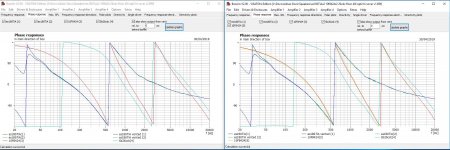 ES180TiA 10F8424 26CDC 1vs2 mid Phase.JPG273.6 KB · Views: 59
ES180TiA 10F8424 26CDC 1vs2 mid Phase.JPG273.6 KB · Views: 59 -
 ES180TiA 10F8424 26CDC 1vs2 mid DirH.JPG251.5 KB · Views: 71
ES180TiA 10F8424 26CDC 1vs2 mid DirH.JPG251.5 KB · Views: 71 -
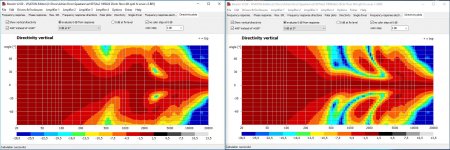 ES180TiA 10F8424 26CDC 1vs2 mid DirV.JPG266.7 KB · Views: 70
ES180TiA 10F8424 26CDC 1vs2 mid DirV.JPG266.7 KB · Views: 70 -
 ES180TiA 10F8424 26CDC 1vs2 mid MaxSPL.JPG335.5 KB · Views: 62
ES180TiA 10F8424 26CDC 1vs2 mid MaxSPL.JPG335.5 KB · Views: 62 -
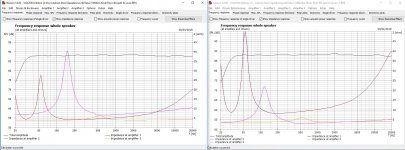 ES180TiA 10F8424 26CDC 1vs2 mid Imp.JPG309 KB · Views: 47
ES180TiA 10F8424 26CDC 1vs2 mid Imp.JPG309 KB · Views: 47 -
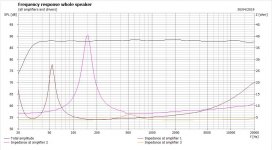 ES180TiAx2 10F8424 26CDC Imp.JPG136.6 KB · Views: 59
ES180TiAx2 10F8424 26CDC Imp.JPG136.6 KB · Views: 59 -
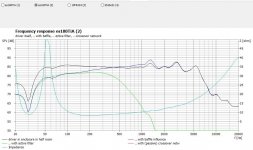 ES180TiAx2 10F8424 26CDC Woofer only.JPG130.6 KB · Views: 69
ES180TiAx2 10F8424 26CDC Woofer only.JPG130.6 KB · Views: 69 -
 ES180TiA 10F8424 26CDC 1vs2 mid Freq.JPG294 KB · Views: 55
ES180TiA 10F8424 26CDC 1vs2 mid Freq.JPG294 KB · Views: 55
Last edited:
Thanks for posting the graphs!
From the directivity I'd prefer the left one horizontally, the right one is very narrow vertically. That can be an advantage as well as a disadvantage. If you always sit at the same height, that's fine, it reduces the reflections of the floor and ceiling. If you often sit on different heights (ie. chair/sofa) or stand up (dance ) it's ..not so good.. You have to chose your own
) it's ..not so good.. You have to chose your own
The simulation uses both excursion and power. That means, whatever is reached first, determines the graph. The simulation shows it goes up to ~102dB in the mids. That actually is party-level. The speakers will still work slightly above that level but the distortion will increase slowly. Peaks of 105dB are not a problem if it isn't nonstop. Believe me, that's plenty to go.
The bass reaches the max excursion at 94 (single) respectively 100dB at 40Hz. If you don't use a lowcut/subsonic filter and the music contains very low frequencies (or you're listening to a record), you'll often max out at ~90dB according to the simulation. In the bass the ear isn't very sensitive for distortion, you can get probably a few dB more. That means, the bass is in all cases the limiting factor.
From the directivity I'd prefer the left one horizontally, the right one is very narrow vertically. That can be an advantage as well as a disadvantage. If you always sit at the same height, that's fine, it reduces the reflections of the floor and ceiling. If you often sit on different heights (ie. chair/sofa) or stand up (dance
The simulation uses both excursion and power. That means, whatever is reached first, determines the graph. The simulation shows it goes up to ~102dB in the mids. That actually is party-level. The speakers will still work slightly above that level but the distortion will increase slowly. Peaks of 105dB are not a problem if it isn't nonstop. Believe me, that's plenty to go.
The bass reaches the max excursion at 94 (single) respectively 100dB at 40Hz. If you don't use a lowcut/subsonic filter and the music contains very low frequencies (or you're listening to a record), you'll often max out at ~90dB according to the simulation. In the bass the ear isn't very sensitive for distortion, you can get probably a few dB more. That means, the bass is in all cases the limiting factor.
OK it looks like SS 10F can give the spl needed in the low end
Test Bench - Scan-Speak 10F/8414G10 Small 3.5” Full-Range Woofer | audioXpress
I have a pretty similar 3-way project on hold here. Mid is Audax HM100z0, cone diameter 85mm, Fs is higher around 250Hz ( a dedicated midrange)
Avalanche AS1 modernization
Test Bench - Scan-Speak 10F/8414G10 Small 3.5” Full-Range Woofer | audioXpress
I have a pretty similar 3-way project on hold here. Mid is Audax HM100z0, cone diameter 85mm, Fs is higher around 250Hz ( a dedicated midrange)
Avalanche AS1 modernization
Last edited:
Thanks again all for the responses. I may try looking at offsetting the mid/tweeter to see if this helps the horizontal dispersion any.
Found this project the other night, include s MTMWW Dayton driver based version that look nice, similar to the Speaker Design Works Statement Series.
Project NEXUS... A timbre matched family of Hi-Fi/HT speakers | HiFiCircuit
Speaker Design Works
P.S. I also looked at the TB W4-1337 SA (neo version as used in the Statement Monitor) but again does not model as well as the 10F8824.
Found this project the other night, include s MTMWW Dayton driver based version that look nice, similar to the Speaker Design Works Statement Series.
Project NEXUS... A timbre matched family of Hi-Fi/HT speakers | HiFiCircuit
Speaker Design Works
P.S. I also looked at the TB W4-1337 SA (neo version as used in the Statement Monitor) but again does not model as well as the 10F8824.
Thanks Zvu, I also noted that the 10F8842 does not seem to have the 1-1.5kHz "wiggle" in the frequency plot that many of the others seem to exhibit (proposed to be due to the surround). This is very marked on the Satory MW16P but most reports suggest that it is inaudible. The 10F8824 has a nice rise in frequency over the range which seems to also be desirable according to many comments.
Think I will be sticking to my original TMWW design and trying a few minor tweaks to driver position/box size/port to see if I can optimise further.
As always the plan would be to buy, build the box (I assume as inert as possible, have some ideas on that), measure individual drivers in the box, analyse and calculate crossovers and then test complete system in the box and optimise (crossover and add notches), finally then optimise for room resonances once in situ.
There is a possibility I can be able to get access to a decent size (2.5m cube) anechoic chamber for measurement which may help quite a bit, get it right in there and then there is only the room to deal with. With Minidsp I think I can have 4 "calibrations", will probably look at anechoic flat, room flat, room flat with 6db slope and finally with 1-3khz enhancement (not sure about the last).
Think I will be sticking to my original TMWW design and trying a few minor tweaks to driver position/box size/port to see if I can optimise further.
As always the plan would be to buy, build the box (I assume as inert as possible, have some ideas on that), measure individual drivers in the box, analyse and calculate crossovers and then test complete system in the box and optimise (crossover and add notches), finally then optimise for room resonances once in situ.
There is a possibility I can be able to get access to a decent size (2.5m cube) anechoic chamber for measurement which may help quite a bit, get it right in there and then there is only the room to deal with. With Minidsp I think I can have 4 "calibrations", will probably look at anechoic flat, room flat, room flat with 6db slope and finally with 1-3khz enhancement (not sure about the last).
Thanks for the help so far.
Got a supplementary question.
How important is it to have an enclosure that is well damped?
I like the idea of the curved shape speakers but would use flexi ply for them rather than the CNC stacked process. The curves obviously help with rear reflection but also add structural stiffness to the box (would add three window pane braces above, in between and below the two woofers). Now, if I use 5mm flexi ply I can get the bend radiuses I need. So, if I sandwich 5mm rubber sheet inbetween the ply to form a 5 layer, 25mm sandwich (fully bonding the layers together) I think I can get the shape I want and have a very “inert” box. Is this a good thing?
Just to add I will use the Troels damping scheme as a starter for ten and then adjust (walls, behind drivers and top/bottom extra damping material). Also I may add a layer of 1.5mm aluminium on the outside as a final finish that I can either polish or brush, this will be adhered fully to the ply outer skin.
Any thoughts?
Got a supplementary question.
How important is it to have an enclosure that is well damped?
I like the idea of the curved shape speakers but would use flexi ply for them rather than the CNC stacked process. The curves obviously help with rear reflection but also add structural stiffness to the box (would add three window pane braces above, in between and below the two woofers). Now, if I use 5mm flexi ply I can get the bend radiuses I need. So, if I sandwich 5mm rubber sheet inbetween the ply to form a 5 layer, 25mm sandwich (fully bonding the layers together) I think I can get the shape I want and have a very “inert” box. Is this a good thing?
Just to add I will use the Troels damping scheme as a starter for ten and then adjust (walls, behind drivers and top/bottom extra damping material). Also I may add a layer of 1.5mm aluminium on the outside as a final finish that I can either polish or brush, this will be adhered fully to the ply outer skin.
Any thoughts?
Last edited:
How important is it to have an enclosure that is well damped?
Hi,
The first thing that comes to mind is the 40l cabinet volume for 2 x ES180TiA...
It's no longer a pencil/tower 3 way of minimal footprint. All I'll say is don't forget the additional volume losses for separate chamber(s), internal bracing etc. It soon adds up!
Re 2 x woofers. Not sure of your reasoning behind TMWW or other variants of ***WW, but I don't think you'll need dual woofers TBH... I just have TMW which fills my room just nicely IMO. I think a sub integrated at a later stage might just bare more fruit if you find the bass lacking down the track.
On the other thread you asked about the sound of ES180TiA... IMO this will depend on your cabinet build (Take the following with a grain of salt)... this is just my take on it.
IMO your cabinet needs to be *everything* that will let this driver shine. Everything might be defined as sturdy, rigid and very well braced but not to the point of the ridiculous... surely we want to hear the character of the driver, otherwise why choose it?
Even though I used a mid dome with closed back I still put it in a separate chamber with the tweeter and left the remaining volume for the woofer. This allowed me to build and 'tune' a cabinet with just the ES180TiA in mind. And to top it all off, I went away from the sage advice on these forums and used solid timber and not ply or MDF for the cabinets, albeit solid 'laminated' timber (Acacia).
cheers
First we must remember that this will be a 3-way design. I suppose that the W-M xo will be 2-300Hz, so it's internal shape/contour plays minimal role. At those wavelengths curvatures and roundovers, coating or unparallel walls don't have an effect. Rigidity of walls is primary concern and curvature helps to get that with less thickness. As well drivers's top end response is rather meaningless, instead of resonance freq and motor linearity etc. in which Esoteric shines too, at least the little sister here
Test Bench - Dayton Audio ES140Ti-8 5.5” Midwoofer | audioXpress
Midrange driver needs it's own chamber and it's internal shape, lining and stuffing is far more important to attenuate standing waves. Baffle edge rounding gets important too and surprisingly small details matter! It spans at least 3 octaves and the most critical range for hearing also "nasties"
About the chamber for 10F Help with midrange chamber design
Test Bench - Dayton Audio ES140Ti-8 5.5” Midwoofer | audioXpress
Midrange driver needs it's own chamber and it's internal shape, lining and stuffing is far more important to attenuate standing waves. Baffle edge rounding gets important too and surprisingly small details matter! It spans at least 3 octaves and the most critical range for hearing also "nasties"
About the chamber for 10F Help with midrange chamber design
Last edited:
- Status
- This old topic is closed. If you want to reopen this topic, contact a moderator using the "Report Post" button.
- Home
- Loudspeakers
- Multi-Way
- Project Idea - comments please
